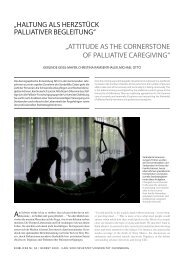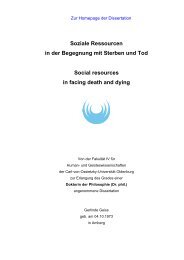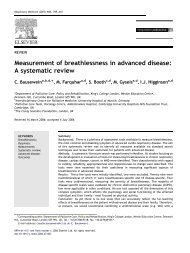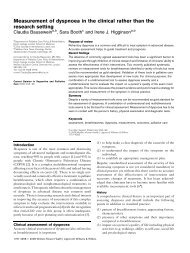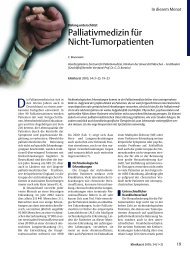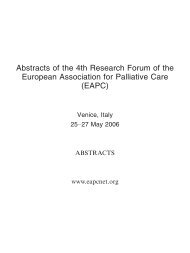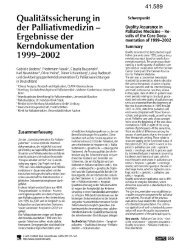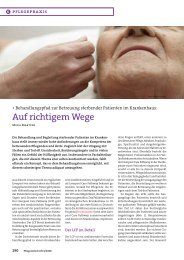EAPC - ipac
EAPC - ipac
EAPC - ipac
You also want an ePaper? Increase the reach of your titles
YUMPU automatically turns print PDFs into web optimized ePapers that Google loves.
440 <strong>EAPC</strong> Abstracts<br />
Significantly fewer patients on the pain-adjusted dose received adjunct<br />
analgesics (58.0% vs. 70.5%). More than 50% of patients had time-of-day<br />
fluctuation in pain intensity at start of study (mean 5.6 (midday) – 6.5<br />
(night). At day 7, levels had significantly decreased to mean 2.8 (night,<br />
morning, midday) or mean 2.9 (evening). By the end, more patients on<br />
pain-adjusted dosage showed improved pain relief than those on fixed dose<br />
(73.8% vs. 70.5%). Quality of life improved more than 50% overall. On<br />
final exam, physicians rated fluctuation as “much improved“ or “improved”<br />
for 88.8% of patients on pain-adjusted dosage. 91.7% of physicians rated<br />
HM efficacy and tolerability as “very good“ or “good“. Conclusions: More<br />
than 50% of patients reported time-of-day differences in pain intensity.<br />
Flexible, 2xday HM dosage improved even time-of-day fluctuation in pain<br />
intensity and quality of life; pain levels dropped through pain-adjusted<br />
dosage. * Palladon ® , Mundipharma GmbH.<br />
136 Oral Presentation<br />
Pain 2<br />
Quality of life in patients treated with controlled release dihydrocodeine<br />
and tramadol – results of a prospective, randomized,<br />
cross-over study<br />
Authors: Wojciech Leppert Chair and Department of Palliative<br />
MedicinePoznan University of Medical Sciences POLAND<br />
Mikolaj Majkowicz Department of Quality of Life Research, Gdansk<br />
Medical University Gdansk POLAND<br />
Background: The aim of the study to assess analgesia, side effects and<br />
quality of life (QL) during dihydrocodeine controlled release tablets (DHC<br />
Continus ® 60, 90, 120 mg) and tramadol controlled release tablets<br />
(Tramundin ® 100 mg, Tramal Retard ® 100, 150, 200 mg) administration to<br />
patients with cancer pain Methods: Prospective, 30 opioid – naive patients<br />
with moderate to severe cancer pain intensity of nociceptive (visceral or<br />
somatic) type treated with non-opioid analgesics, randomised, cross–over,<br />
7 days each no wash – out. Visceral pain 14 patients, bone 10 and mixed 6.<br />
Pain intensity: 24 patients moderate (NRS 3 – 5), 6 severe (NRS > 5).<br />
Analgesia by NRS (Brief Pain Inventory – Short Form), side effects verbal<br />
scale, ESAS, QL by EORTC QLQ C 30. Starting initial dose DHC 2x60<br />
mg, titrated 2x90,2x120 up to 2x180 or 3x120, tramadol 2x100 mg, titrated<br />
2x150, 2x200 up to 2x300 or 3 x 200. Changing drugs – equianalgesic<br />
doses (tramadol = DHC): 2x100 = 2x60, 2x150 = 2x90, 2x200 = 2x120,<br />
2x300 = 2x180. Results: Significant pain relief in both groups but analgesia<br />
significantly superior in DHC group and there was less nausea and less<br />
dyspnoea. Constipation and drowsiness significantly more intense in DHC<br />
group. Global QL better in DHC group. In both groups side effects did not<br />
caused cessation of the treatment and respiratory depression not observed.<br />
Conclusions: 1. Dihydrocodeine and tramadol in controlled release tablets<br />
are effective analgesics in the treatment of nociceptive cancer pain of moderate<br />
intensity but DHC provided significantly better analgesia. 2. Quality<br />
of life results showed better analgesia and global QL in DHC group and<br />
more intense nausea, less drowsiness and less constipation in tramadol<br />
group. The tolerance of the treatment was good in both groups with no serious<br />
side effects like respiratory depression or allergy for the drug. 3. The<br />
second step of the WHO analgesic ladder is important for the treatment of<br />
patients with nociceptive cancer pain of moderate intensity.<br />
137 Oral Presentation<br />
Pain 2<br />
A randomised, double-blind, placebo-controlled, parallel-group<br />
study comparing oral racemic ketamine and S ketamine in the<br />
treatment of cancer-related neuropathic pain<br />
Authors: Marie Fallon Palliative Medicine University of Edinburgh<br />
UNITED KINGDOM<br />
Caroline Bray Beatson Oncology Centre Glasgow UNITED KINGDOM<br />
Angela Boyd University of Edinburgh Edinburgh UNITED KINGDOM<br />
Terry Nichols Napp Pharmaceuticals Ltd (now Mundipharma Research<br />
Ltd) Cambridge UNITED KINGDOM<br />
Lesley Colvin University of Edinburgh Edinburgh UNITED KINGDOM<br />
AJ Miller Napp Pharmaceuticals Ltd Cambridge UNITED KINGDOM<br />
O’Brien Cathy Fincham Statistics Fincham UNITED KINGDOM<br />
Barry Laird University of Edinburgh Edinburgh UNITED KINGDOM<br />
Background: Neuropathic cancer pain remains a clinical challenge. The S-<br />
enantiomer of the NMDA receptor antagonist ketamine may provide analgesia<br />
with a greater potency than racemic ketamine with fewer excitatory<br />
side effects. This study evaluated the efficacy and tolerability of oral solutions<br />
of S-ketamine, racemic ketamine, and placebo in moderate to severe,<br />
cancer-related, neuropathic pain. Methods: A multi-centre randomised controlled<br />
trial which recruited patients from hospitals and hospices in the UK.<br />
Inclusion criteria: moderate to severe, cancer related neuropathic pain,<br />
despite treatment with a strong opioid for moderate to severe pain. The<br />
study consisted of a titration period of up to seven days, followed by a two<br />
day assessment period. The primary efficacy variable was pain intensity<br />
which was assessed using the Box-11 pain score. Other efficacy measures<br />
included the Brief Pain Inventory (BPI) and short-form McGill Pain<br />
Questionnaire(MPQ). Results: 65 patients were recruited with 22 (34%)<br />
receiving S-ketamine, 22 (34%) racemic ketamine, and 21 (32%) placebo.<br />
38 patients (84%) completed the study. S-Ketamine, racemic ketamine and<br />
placebo were associated with analgesia and there was no statistically significant<br />
differences between treatment groups in the primary efficacy variable<br />
during the assessment period (ANCOVA morning: P=0.829, midday:<br />
P=0.480, evening: P=0.844). S-ketamine provided the largest reduction in<br />
the MPQ sensory, affective, and total pain intensity scores (total mean pain<br />
intensity scores: 21.9 [SD 8.7] at baseline to 4.9 [SD 6.4] at study endpoint)<br />
but this did not reach statistical significance (sensory pain: P=0.068, affective<br />
pain: P=0.316, and total pain P=0.073). Conclusions: Based on the primary<br />
efficacy variable, the analgesic effects of ketamine and S-ketamine<br />
were not statistically significant from placebo. Beneficial trends were<br />
observed in the MPQ sensory descriptors. A much larger trial would be<br />
required to show statistical significance.<br />
138 Oral Presentation<br />
Pain 2<br />
Can gradual dose titration of ketamine prevent psychotomimetic<br />
effects of advanced cancer patients with neuropathic<br />
pain<br />
Authors: Yoshiaki Okamoto Graduate School of Pharmaceutical Science<br />
Osaka University JAPAN<br />
Yumiko Ono Osaka University Suita Osaka JAPAN<br />
Soitiro Yasuda Osaka University Suita Osaka JAPAN<br />
Keiko Tazumi Osaka University Suita Osaka JAPAN<br />
Satoru Tsuneto Osaka University Suita/Osaka JAPAN<br />
Sho Goya Osaka University Suita Osaka JAPAN<br />
Hitoshi Tanimukai Osaka University Suita Osaka JAPAN<br />
Yoichi Matsuda Osaka University Suita Osaka JAPAN<br />
Hiroshi Eto Osaka University Suita Osaka JAPAN<br />
Yoshie Toya Osaka University Suita Osaka JAPAN<br />
Etsuko Uejima Osaka University Suita Osaka JAPAN<br />
Nobuo Kurokawa Osaka University Suita Osaka JAPAN<br />
Introduction: Ketamine is an N-methyl-D-aspartate receptor antagonist<br />
and is used to treat neuropathic cancer pain. However, it may cause psychotomimetic<br />
effects such as nightmares, illusions, hallucination, or delirium.<br />
We examined the effectiveness and safety of gradual dose titration of<br />
ketamine in the treatment of neuropathic pain in advanced cancer patients<br />
prospectively. Methods: After we diagnosed neuropathic pain, which did<br />
not respond to opioids in advanced cancer patients, we started ketamine<br />
10mg/24hr by continuous intravenous infusion and increased the dose by<br />
10mg/24hr every 4–6 hours before the dose exceeded 50mg/24hr. After<br />
50mg/24hr, we increased ketamine by 25mg/24hr every 12–24 hours until<br />
pain was relieved. Results: There were 15 men (62.5%) and 9 women<br />
(37.5%), with an average age of 49.2years (SD=18.4), ranging from 13 to<br />
74 years of age. The patients had a variety of tumors, with rectum cancer



